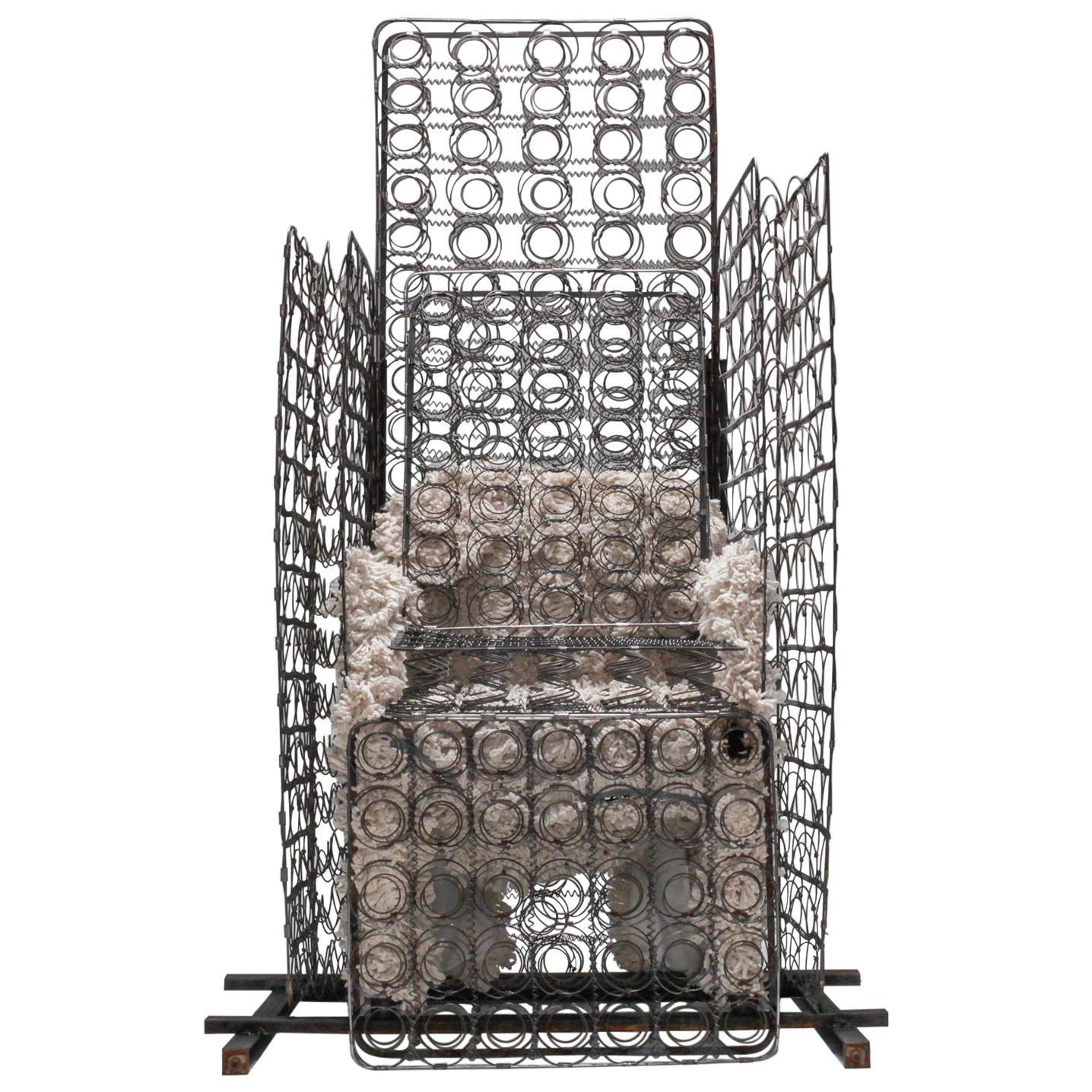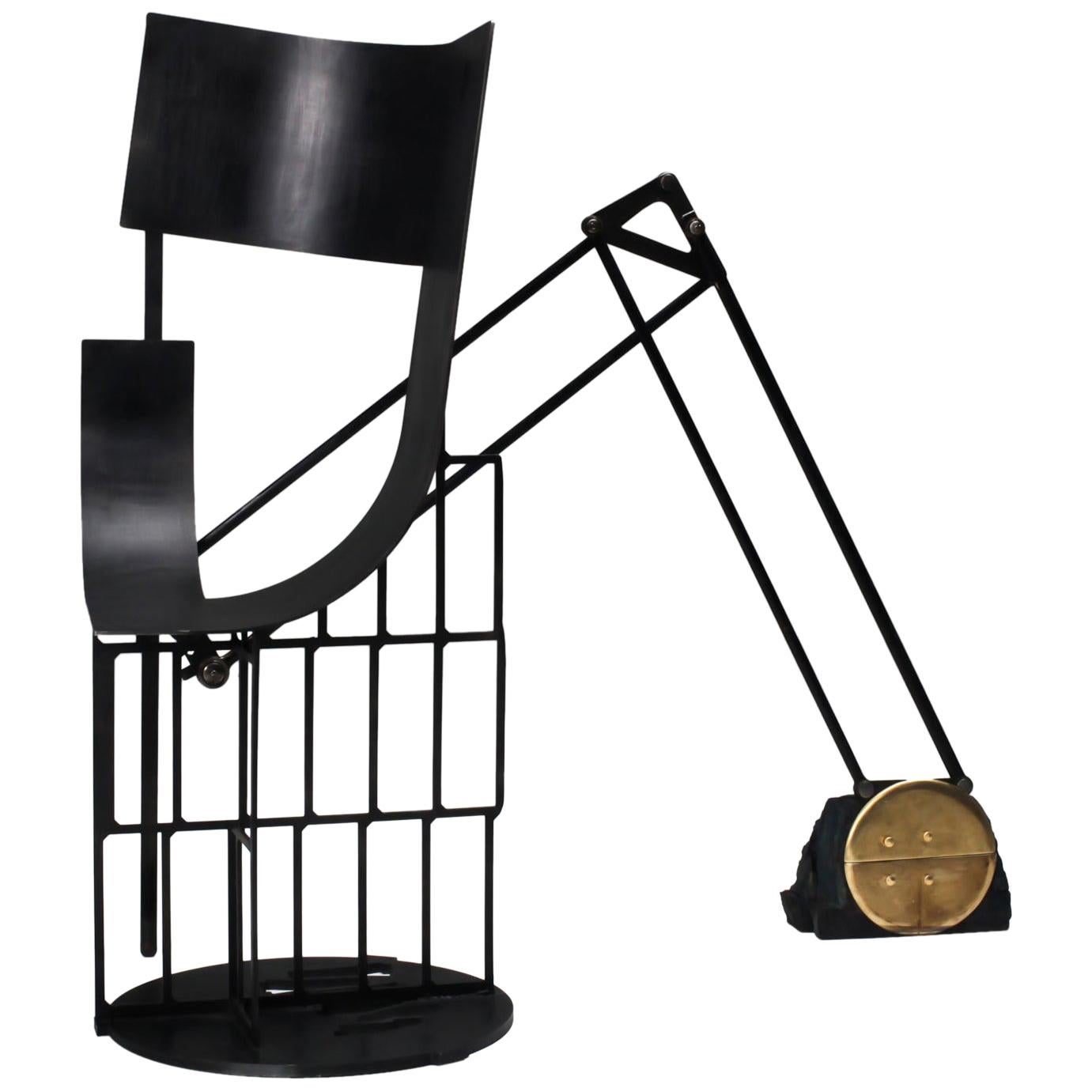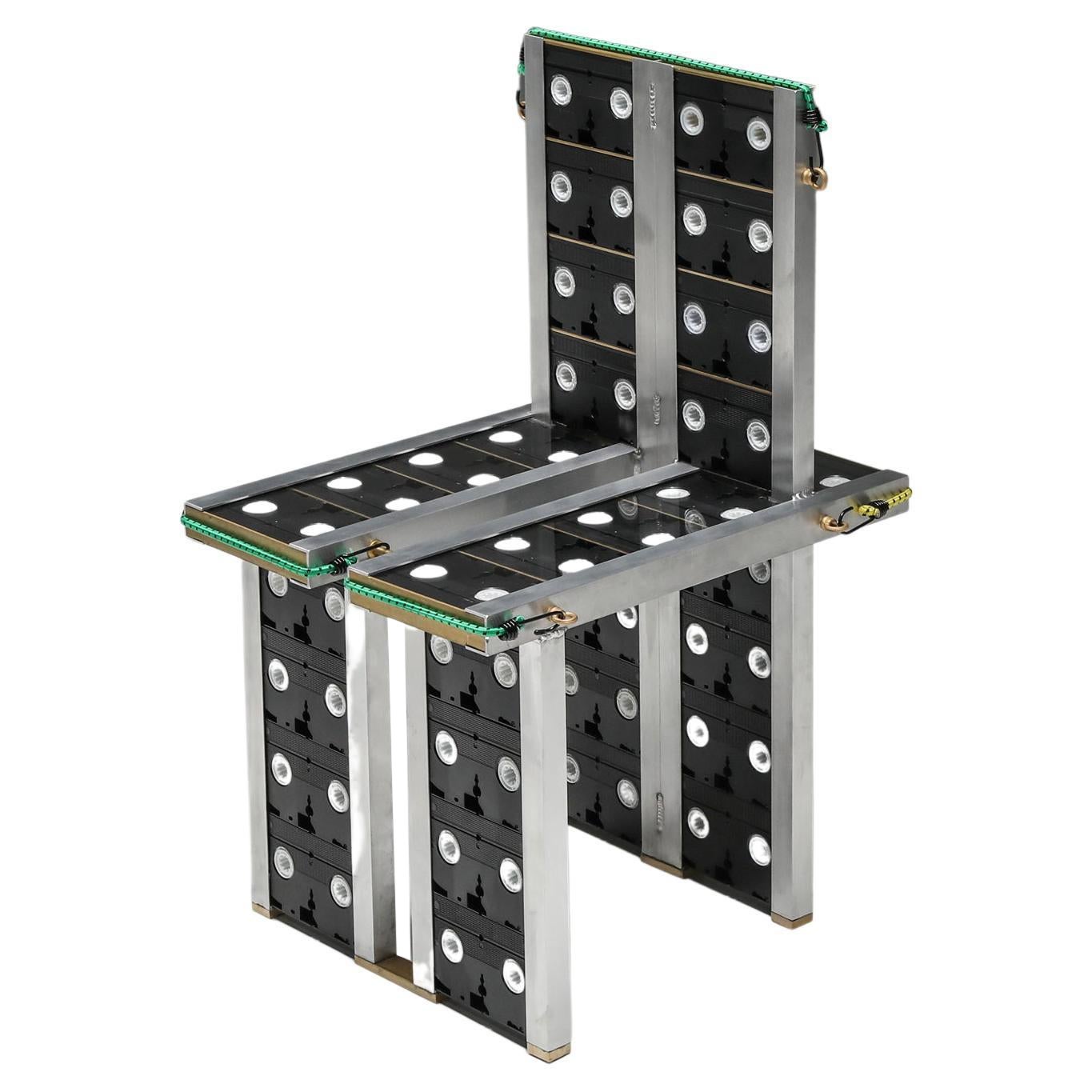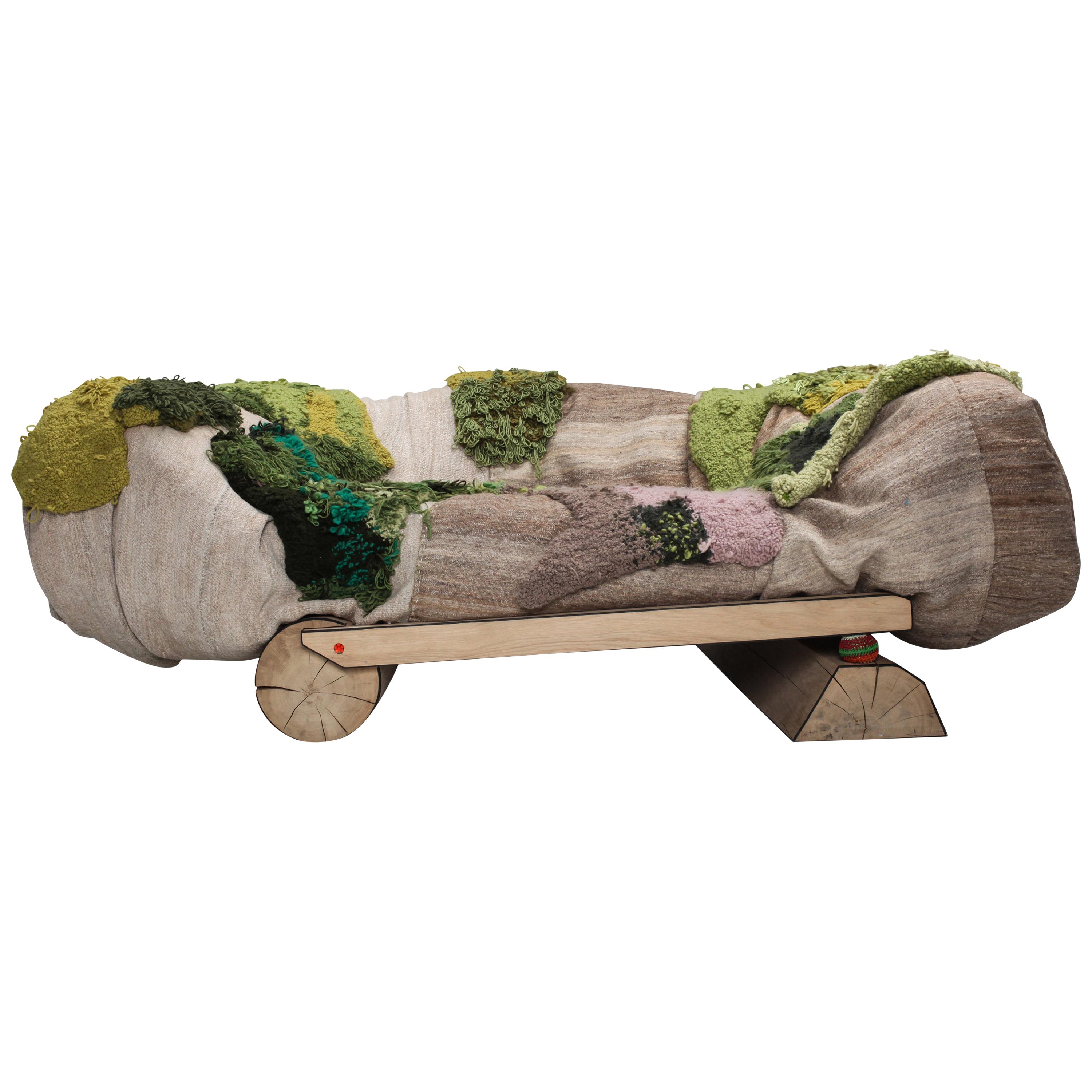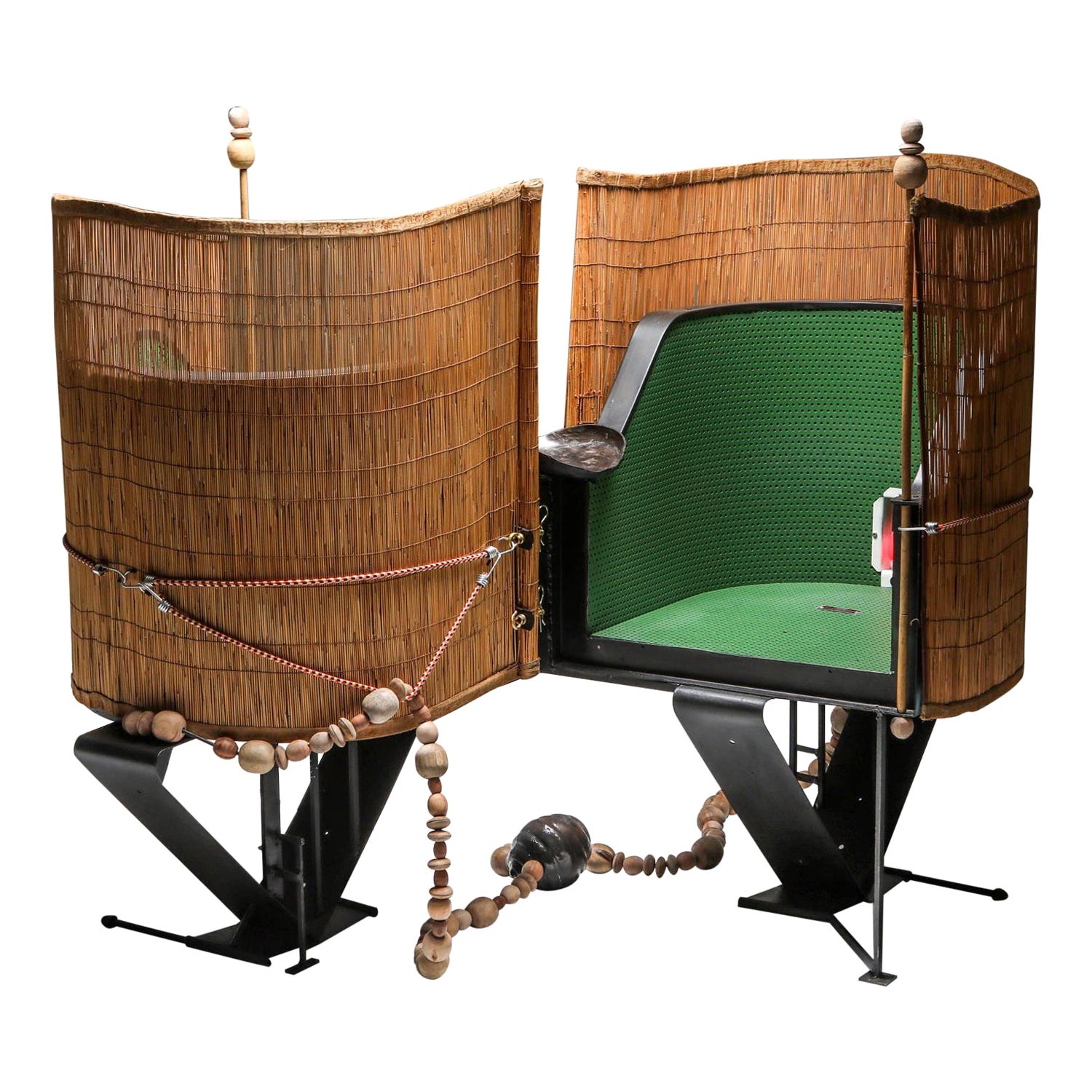Items Similar to 'T-Shink' Sprayed Textile Throne Chair, Lionel Jadot, Belgium, 2020
Want more images or videos?
Request additional images or videos from the seller
1 of 17
'T-Shink' Sprayed Textile Throne Chair, Lionel Jadot, Belgium, 2020
About the Item
The 'T-Shink' functional art throne chair is constructed of elements from wooden moulds which date back to the 1950s and originally used to make stainless steel sinks. These were then flocked and covered with sprayed textile and assembled using an industrial fastening system.
A collectable design which was exhibited in Lionel Jadot's Solo Exhibition 'ENTHRONE DETHRONE Chapter 02' at Everyday Gallery, Antwerp.
Born in Brussels in 1969, Lionel Jadot is an interior designer, artist, designer, filmmaker, adventurer. But all at once, preferably. Lionel Jadot is firing on all cylinders. ‘I never throw anything, I pick up everything. Not having a green thumb, I’m trying cuttings, weddings against nature. I never forget a line.’ He’s inviting us in subtle, off-beat worlds, on the edge of reality. Its material is made of dilated time. A wandering spirit, he seeks a protective balance in a hostile world. It is his constant questioning: what happens to the place where we live? For Lionel Jadot, everything is an object, everything is history. He draws from other places, other times, and seeks what’s linking them. He sews, stitches, unpicks, blends materials, combines eras. He will enshrine some wood essence in metal, some mineral in a plant, the old in the new. ‘I take extra care to the joint between two materials.’ With him, there is always some play in the parts, as in a piece of machinery. From a kingdom to another, he provokes organic, viral growths, generating energy. Linking past and future, he never forgets a line. ‘I accumulate them.’ He’s inviting us in subtle worlds, off-beat, on the edge of reality. Are we in 1930 or 2030? Both, no doubt. Its material is made of dilated time.
The eye goes hand in hand with the ear. ‘When I walk into a place, I listen to the good (or bad) it does to me. An ineffable feeling.’ He recreates mutant buildings, like the future Royal Botanique, a 5 stars hotel housed in the Church of the Gesu, a former convent behind a 1940 façade. He talks about a ‘hotel object’, which he holds and turns around in his hand.
A wandering spirit, he’s flirting with retro-futurism. The Jam, another hotel, is intended for urban travellers, fans of swiftness, fluidity, and hospitality. He designs interiors as a set of objects: a motorcycle cut in concrete becomes a bar counter. He finds gothic cartoon echoes, from the likes of Moebius, Alejandro Jodorowsky, Enki Bilal, sets from Garage Hermétique and Blade Runner, a
protective balance in a hostile world.
Discovering Jadot’s little cosmos of collected and accumulated goods, it becomes clear that every element has its own story. I tried to collect them and in turn, devour them in the coming paragraphs. But first: the show is best experienced seated, barring the distinction between the object of use and object of attention, they invite for different types of conversation. The seats, chairs, thrones all make us think of our own physical comportment, and of how the seat lends grandeur to the person sitting on it, by crowning its presence. The crackling floor, the felt walls, and the diffused light slows you down into an oddly absorbing environment, in which you are left puzzled.
In the eclectic collages of objects, bits and pieces collected all over the world come together in ways practical, and logical, though possibly only in the artist’s mind. All his finds eventually seem to fall into place. Starting with the mere conception of a chair, rather than with a set-out plan or sketch, the works are intuitively construed out of an archive that one can only imagine the dimensions of. Things forgotten by others, precious for him, were all once designed for their own purpose. Here they find their fit as a base, a closing system or a balancing element.
Stories assembled at goodwill, Lionel Jadot finds solutions while playfully paving its very own middle ground between art and object.
- Creator:Lionel Jadot (Artist)
- Dimensions:Height: 63 in (160 cm)Width: 59.06 in (150 cm)Depth: 51.19 in (130 cm)Seat Height: 23.63 in (60 cm)
- Style:Post-Modern (In the Style Of)
- Materials and Techniques:
- Place of Origin:
- Period:
- Date of Manufacture:2020
- Production Type:New & Custom(One of a Kind)
- Estimated Production Time:Available Now
- Condition:
- Seller Location:Antwerp, BE
- Reference Number:1stDibs: LU933419739612
About the Seller
4.8
Gold Seller
These expertly vetted sellers are highly rated and consistently exceed customer expectations.
Established in 2008
1stDibs seller since 2012
980 sales on 1stDibs
Typical response time: 10 hours
- ShippingRetrieving quote...Ships From: Antwerp, Belgium
- Return PolicyA return for this item may be initiated within 14 days of delivery.
More From This SellerView All
- Functional Art Chair / Throne "'Spring Swab" by Lionel JadotBy Lionel JadotLocated in Antwerp, BECollectible design / Functional art, Lionel Jadot for Everyday Gallery, Belgium 2020 Born in Brussels in 1969, Lionel Jadot is an interior designer, artist, designer, filmmaker, adventurer. But all at once, preferably. Lionel Jadot is firing on all cylinders. ‘I never throw anything, I pick up everything. Not having a green thumb, I’m trying cuttings, weddings against nature. I never forget a line.’ He’s inviting us in subtle, off-beat worlds, on the edge of reality. Its material is made of dilated time. A wandering spirit, he seeks a protective balance in a hostile world. It is his constant questioning: what happens to the place where we live? For Lionel Jadot, everything is object, everything is history. He draws from other places, other times, and seeks what’s linking them. He sews, stitches, unpicks, blends materials, combines eras. He will enshrine some wood essence in metal, some mineral in a plant, the old in the new. ‘I take extra care to the joint between two materials.’ With him, there is always some play in the parts, as in a piece of machinery. From a kingdom to another, he provokes organic, viral growths, generating energy. Linking past and future, he never forgets a line. ‘I accumulate them.’ He’s inviting us in subtle worlds, off-beat, on the edge of reality. Are we in 1930 or in 2030? Both, no doubt. Its material is made of dilated time. The eye goes hand in hand with the ear. ‘When I walk into a place, I listen to the good (or bad) it does to me. An ineffable feeling.’ He recreates mutant buildings, like the future Royal Botanique, a 5 stars hotel housed in the Church of the Gesu, a former convent behind a 1940 façade. He talks about a ‘hotel object’, which he holds and turns around in his hand. A wandering spirit, he’s flirting with retro-futurism. The Jam, another hotel, is intended for urban travelers, fans of swiftness, fluidity and hospitality. He designs interiors as a set of objects: a motorcycle cut in concrete becomes a bar counter. He finds gothic cartoon echoes, from the likes of Moebius, Alejandro Jodorowsky, Enki Bilal, sets from Garage Hermétique and Blade Runner, a protective balance in a hostile world. Discovering Jadot’s little cosmos of collected and accumulated goods, it becomes clear that every element has its own story. I tried to collect them and in turn, devour them in the coming paragraphs. But first: the show is best experienced seated, barring the distinction between object of use and object of attention, they invite for different types of conversation. The seats, chairs, thrones all make us think of our own physical comportment, and of how the seat lends grandeur to the person sitting on it, by crowning its presence. The crackling floor, the felt walls and the diffuse light slow you down into an oddly absorbing environment, in which you are left puzzled. In the eclectic collages of objects, bits and pieces collected all over the world come together in ways practical, and logical, though possibly only in the artist’s mind. All his finds eventually seem to fall into place. Starting with the mere conception of a chair, rather than with a set-out plan or sketch, the works are intuitively construed out of an archive that one can only imagine the dimensions of. Things forgotten by others, precious for him, were all once designed for their own purpose. Here they find their fit as a base, a closing system or a balancing element. The first piece that opens the exhibition, the most throne-like of all seats in the show, builds around a chair of his grandmother, protected by mops, and harassed with bed springs. As you enter the space, you pass by a shell leaning over a yellow seat that stems from his old Mustang, and find a white stool piece with Mexican leather dog training whips— the white building blocks of which turn out to be dried molding material, as found and broken out of a bucket by workers every morning. Further, the stone piece that reminds one of the stone age, is indeed made of 400 million old rocks, and the soft seats are lent from construction, where these strokes of textile carry up the heaviest goods. In the corner — but as you walk this walk please be seated on any of the thrones and experience the work for a moment— the green fluffy cover is made by XXXX who remakes cartographies of warzones, one of which is here mounted on a flexible fishing chair. On an experience level, the conversation chair enhances self-confidence, while putting you literally in a good spot with the person you’re conversing with. The lamp perfectly shows the playful Cadavre Exquis...Category
2010s Belgian International Style Armchairs
MaterialsMetal
- Functional art Throne / Chair "Black Caterpillar" by Lionel Jadot, 2020By Lionel JadotLocated in Antwerp, BECollectible Design / Functional art, Lionel Jadot for Everyday Gallery, Belgium 2020 The chair made with scrap metal laser cuts and a prototype element of one of Lionel’s coffee table, the legs are made with the pantograph of a drawing table from the 30s, hung on an inked piece of Japanese wood from the 19th piece of furniture. Born in Brussels in 1969, Lionel Jadot is an interior designer, artist, designer, filmmaker, adventurer. But all at once, preferably. Lionel Jadot is firing on all cylinders. ‘I never throw anything, I pick up everything. Not having a green thumb, I’m trying cuttings, weddings against nature. I never forget a line.’ He’s inviting us in subtle, off-beat worlds, on the edge of reality. Its material is made of dilated time. A wandering spirit, he seeks a protective balance in a hostile world. It is his constant questioning: what happens to the place where we live? For Lionel Jadot, everything is object, everything is history. He draws from other places, other times, and seeks what’s linking them. He sews, stitches, unpicks, blends materials, combines eras. He will enshrine some wood essence in metal, some mineral in a plant, the old in the new. ‘I take extra care to the joint between two materials.’ With him, there is always some play in the parts, as in a piece of machinery. From a kingdom to another, he provokes organic, viral growths, generating energy. Linking past and future, he never forgets a line. ‘I accumulate them.’ He’s inviting us in subtle worlds, off-beat, on the edge of reality. Are we in 1930 or in 2030? Both, no doubt. Its material is made of dilated time. The eye goes hand in hand with the ear. ‘When I walk into a place, I listen to the good (or bad) it does to me. An ineffable feeling.’ He recreates mutant buildings, like the future Royal Botanique, a 5 stars hotel housed in the Church of the Gesu, a former convent behind a 1940 façade. He talks about a ‘hotel object’, which he holds and turns around in his hand. A wandering spirit, he’s flirting with retro-futurism. The Jam, another hotel, is intended for urban travelers, fans of swiftness, fluidity and hospitality. He designs interiors as a set of objects: a motorcycle cut in concrete becomes a bar counter. He finds gothic cartoon echoes, from the likes of Moebius, Alejandro Jodorowsky, Enki Bilal, sets from Garage Hermétique and Blade Runner, a protective balance in a hostile world. Discovering Jadot’s little cosmos of collected and accumulated goods, it becomes clear that every element has its own story. I tried to collect them and in turn, devour them in the coming paragraphs. But first: the show is best experienced seated, barring the distinction between object of use and object of attention, they invite for different types of conversation. The seats, chairs, thrones all make us think of our own physical comportment, and of how the seat lends grandeur to the person sitting on it, by crowning its presence. The crackling floor, the felt walls and the diffuse light slow you down into an oddly absorbing environment, in which you are left puzzled. In the eclectic collages of objects, bits and pieces collected all over the world come together in ways practical, and logical, though possibly only in the artist’s mind. All his finds eventually seem to fall into place. Starting with the mere conception of a chair, rather than with a set-out plan or sketch, the works are intuitively construed out of an archive that one can only imagine the dimensions of. Things forgotten by others, precious for him, were all once designed for their own purpose. Here they find their fit as a base, a closing system or a balancing element. The first piece that opens the exhibition, the most throne-like of all seats in the show, builds around a chair of his grandmother, protected by mops, and harassed with bed springs. As you enter the space, you pass by a shell leaning over a yellow seat that stems from his old Mustang, and find a white stool piece with Mexican leather dog training whips— the white building blocks of which turn out to be dried molding material, as found and broken out of a bucket by workers every morning. Further, the stone piece that reminds one of the stone age, is indeed made of 400 million old rocks, and the soft seats are lent from construction, where these strokes of textile carry up the heaviest goods. In the corner — but as you walk this walk please be seated on any of the thrones and experience the work for a moment— the green fluffy cover is made by XXXX who remakes cartographies of warzones, one of which is here mounted on a flexible fishing chair...Category
2010s European Chairs
MaterialsBrass, Steel
- 'Frozen Culture' Assemblage Video Cassette Lounge Chair, Lionel Jadot, 2020By Lionel JadotLocated in Antwerp, BEThe ‘Frozen Culture’ chair is a unique functional art piece with a history. Constructed from a set of 35,000 VHS cassettes that were recorded over the course of 25 years by an indivi...Category
2010s Belgian Post-Modern Chairs
MaterialsOther
- Functional Art 'SLV Chair' by Lionel Jadot, Belgium, 2021By Lionel JadotLocated in Antwerp, BEDesign Miami; Art Design; Art Basel; Atelier Lionel Jadot; Everyday Gallery; Contemporary; Belgian Design; Belgian Art; Chair; Functional Sculpture; Artwork; Collectible Design; Ever...Category
2010s Belgian Organic Modern Chairs
MaterialsAluminum
- 'Sit in My Valley II' Sofa by Lionel Jadot, 2020By Lionel JadotLocated in Antwerp, BESit in My Valley II Sofa by by Belgian artist Lionel Jadot, renowned for his unique assemblage of various historical elements into captivating and uni...Category
2010s Belgian Post-Modern Chairs
MaterialsWool, Oak
- Functional Art Chair / Throne "Left at the End of the Corridor" by Lionel JadotBy Lionel JadotLocated in Antwerp, BE'Left At The End of the Corridor' conversation piece by Lionel Jadot for Everyday Gallery, 2020 Collectible Design / Functional art, Lionel Jadot for Everyday Gallery, Belgium 2020 Born in Brussels in 1969, Lionel Jadot is an interior designer, artist, designer, filmmaker, adventurer. But all at once, preferably. Lionel Jadot is firing on all cylinders. ‘I never throw anything, I pick up everything. Not having a green thumb, I’m trying cuttings, weddings against nature. I never forget a line.’ He’s inviting us in subtle, off-beat worlds, on the edge of reality. Its material is made of dilated time. A wandering spirit, he seeks a protective balance in a hostile world. It is his constant questioning: what happens to the place where we live? For Lionel Jadot, everything is object, everything is history. He draws from other places, other times, and seeks what’s linking them. He sews, stitches, unpicks, blends materials, combines eras. He will enshrine some wood essence in metal, some mineral in a plant, the old in the new. ‘I take extra care to the joint between two materials.’ With him, there is always some play in the parts, as in a piece of machinery. From a kingdom to another, he provokes organic, viral growths, generating energy. Linking past and future, he never forgets a line. ‘I accumulate them.’ He’s inviting us in subtle worlds, off-beat, on the edge of reality. Are we in 1930 or in 2030? Both, no doubt. Its material is made of dilated time. The eye goes hand in hand with the ear. ‘When I walk into a place, I listen to the good (or bad) it does to me. An ineffable feeling.’ He recreates mutant buildings, like the future Royal Botanique, a 5 stars hotel housed in the Church of the Gesu, a former convent behind a 1940 façade. He talks about a ‘hotel object’, which he holds and turns around in his hand. A wandering spirit, he’s flirting with retro-futurism. The Jam, another hotel, is intended for urban travelers, fans of swiftness, fluidity and hospitality. He designs interiors as a set of objects: a motorcycle cut in concrete becomes a bar counter. He finds gothic cartoon echoes, from the likes of Moebius, Alejandro Jodorowsky, Enki Bilal, sets from Garage Hermétique and Blade Runner, a protective balance in a hostile world. Discovering Jadot’s little cosmos of collected and accumulated goods, it becomes clear that every element has its own story. I tried to collect them and in turn, devour them in the coming paragraphs. But first: the show is best experienced seated, barring the distinction between object of use and object of attention, they invite for different types of conversation. The seats, chairs, thrones all make us think of our own physical comportment, and of how the seat lends grandeur to the person sitting on it, by crowning its presence. The crackling floor, the felt walls and the diffuse light slow you down into an oddly absorbing environment, in which you are left puzzled. In the eclectic collages of objects, bits and pieces collected all over the world come together in ways practical, and logical, though possibly only in the artist’s mind. All his finds eventually seem to fall into place. Starting with the mere conception of a chair, rather than with a set-out plan or sketch, the works are intuitively construed out of an archive that one can only imagine the dimensions of. Things forgotten by others, precious for him, were all once designed for their own purpose. Here they find their fit as a base, a closing system or a balancing element. The first piece that opens the exhibition, the most throne-like of all seats in the show, builds around a chair of his grandmother, protected by mops, and harassed with bed springs. As you enter the space, you pass by a shell leaning over a yellow seat that stems from his old Mustang, and find a white stool piece with Mexican leather dog training whips— the white building blocks of which turn out to be dried molding material, as found and broken out of a bucket by workers every morning. Further, the stone piece that reminds one of the stone age, is indeed made of 400 million old rocks, and the soft seats are lent from construction, where these strokes of textile carry up the heaviest goods. In the corner — but as you walk this walk please be seated on any of the thrones and experience the work for a moment— the green fluffy cover is made by XXXX who remakes cartographies of warzones, one of which is here mounted on a flexible fishing chair. On an experience level, the conversation chair enhances self-confidence, while putting you literally in a good spot with the person you’re conversing with. The lamp perfectly shows the playful Cadavre Exquis...Category
2010s Belgian Post-Modern Armchairs
MaterialsSteel
You May Also Like
- Lionel Jadot, Crushed Seat, BEBy Lionel JadotLocated in New York, NYCrushed seat, Jadot’s juxtaposed material assemblage, is a colossal manifestation of his unusual creative process. Constructed of reclaimed MDF that has been painted in vibrant color...Category
2010s Belgian Loveseats
MaterialsFoam, Reclaimed Wood, Paint
- Throne Chair with Incredible CarvingLocated in Chicago, ILOver the top carved throne chair with storage under seat. Incredible quality and rarity.Category
Antique 1840s Italian Chairs
MaterialsWood
- Carved African Bamileke Throne ChairLocated in Troy, MIThis circa 1980s hand carved African chair was made by a member of the Bamileke tribe from Cameroon. Hand carved dark stained wood arm chair with rounded, open-work back that feature...Category
Mid-20th Century Cameroonian Tribal Armchairs
MaterialsWood
- 19th Century Italian Walnut Throne ChairLocated in Los Angeles, CASingle 19th century Italian finely carved walnut throne chair with mohair fabric.Category
Antique 19th Century Italian Armchairs
MaterialsGold Leaf
- Silvered Metal and Red Velvet Throne ChairLocated in London, GBSilvered metal and red velvet throne chair Indian, circa 1880 Measures: Height 138cm, width 66cm, depth 66cm This fine Indian throne chair would have been popular in Europe as well as India in the 19th century. The detailed silvered metal chair...Category
Antique Late 19th Century Indian Anglo-Indian Chairs
MaterialsMetal
- Custom Royal French Style Oversized Throne ChairLocated in Bridgeport, CTA very theatrical large throne chair in a custom treatment. With an intricately carved frame having stylized shells and scrolls with the foot a raised snail’s head...Category
20th Century Rococo Armchairs
MaterialsFabric, Wood
